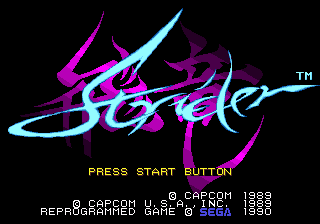Difference between revisions of "Strider"
From Sega Retro
| Line 5: | Line 5: | ||
| publisher=[[Capcom]] | | publisher=[[Capcom]] | ||
| developer=[[Capcom]] | | developer=[[Capcom]] | ||
| − | | system=Arcade, [[Sega Mega Drive]], [[Sega Master System]], Amiga, Amstrad CPC, Atari ST, Commodore 64, DOS, TurboGrafx CD, ZX Spectrum | + | | system=Arcade, [[Sega Mega Drive]], [[Sega Master System]], Amiga, Amstrad CPC, Atari ST, Commodore 64, DOS, TurboGrafx CD, ZX Spectrum |
| − | | romsize= | + | | romsize=[[File:logo-md.png|16px]] 1MB [[File:logo-sms.png|16px]] 512kB |
| sounddriver= | | sounddriver= | ||
| peripherals= | | peripherals= | ||
Revision as of 13:51, 16 August 2010
| Strider |
|---|
| System(s): Arcade, Sega Mega Drive, Sega Master System, Amiga, Amstrad CPC, Atari ST, Commodore 64, DOS, TurboGrafx CD, ZX Spectrum |
| Publisher: Capcom |
| Developer: Capcom |
| Genre: Action |
| Number of players: 1 |
Strider, known in Japan as Strider Hiryu (ストライダー飛竜) is an arcade action game developed by Capcom in 1989. It was subsequently brought to home consoles and computers, including the Sega Mega Drive, Sega Master System, Amiga, Amstrad CPC, Atari ST, Commodore 64, DOS, TurboGrafx CD and ZX Spectrum.
Strider on the Sega Mega Drive was seen as one of the hard hitting 16-bit action games designed to help users to migrate from Nintendo's NES to Sega's console, boasting high definition graphics and recorded speech samples. The NES version of Strider is an entirely different game due to the console's restictions, but the Mega Drive version was for a while the most accurate home arcade conversion of the game.
Strider was unofficially followed by U.S. Gold's Strider II, though Capcom later returned in 1999 to make a true sequel under the name of Strider 2.
Physical Scans
Mega Drive Version
Master System Version
- Strider SMS US Cart.jpg
US cart








